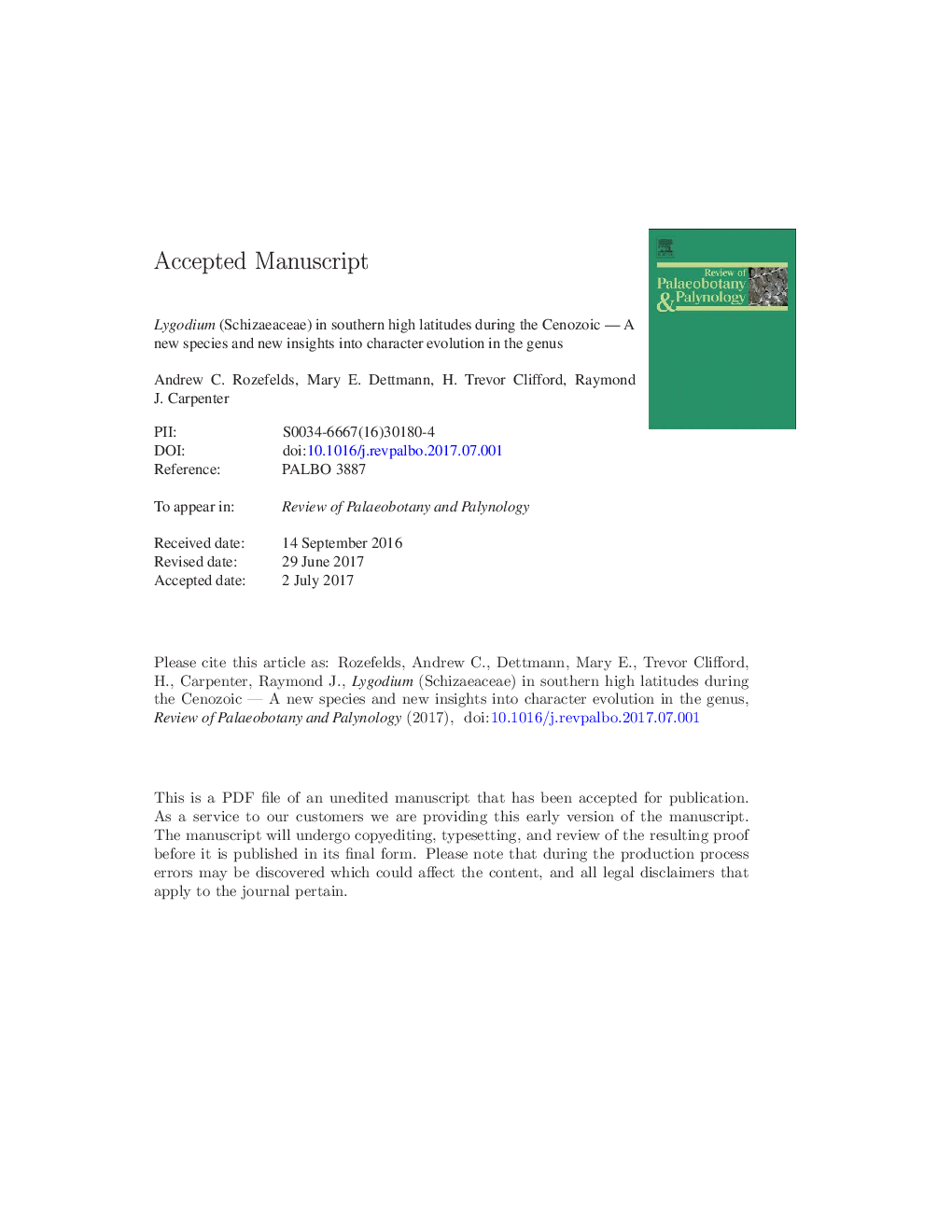| کد مقاله | کد نشریه | سال انتشار | مقاله انگلیسی | نسخه تمام متن |
|---|---|---|---|---|
| 5788293 | 1642450 | 2017 | 50 صفحه PDF | دانلود رایگان |
عنوان انگلیسی مقاله ISI
Lygodium (Schizaeaceae) in southern high latitudes during the Cenozoic - A new species and new insights into character evolution in the genus
دانلود مقاله + سفارش ترجمه
دانلود مقاله ISI انگلیسی
رایگان برای ایرانیان
کلمات کلیدی
موضوعات مرتبط
مهندسی و علوم پایه
علوم زمین و سیارات
فسیل شناسی
پیش نمایش صفحه اول مقاله

چکیده انگلیسی
Utilising both macrofossil and spore evidence the fern, Lygodium Swartz, is shown to be common in the Cenozoic of eastern Australia. A new species, Lygodium goonyellum sp. nov. that has laminate fertile pinnules with crenulate margins and reticulate spore morphology (Crassiretitriletes vanraadshoovenii Germeraad, Hopping et Muller), is described from Suttor Formation or its equivalents, near Moranbah, Queensland. Palynological data and isotopic dates support an Oligocene-early Miocene age for this unit. The laminate fertile pinnules and spores in L. goonyellum are morphologically similar to those of extant Lygodium microphyllum (A.J.Cavanilles) R.Brown and Lygodium reticulatum Schkuhr. It differs from the Australian Paleogene species Lygodium dinmorphyllum Churchill in both laminate fertile pinnules and reticulate spores. Additional distributional data on L. dinmorphyllum is provided, utilising evidence from both macrofossils and the dispersed spore record of Cyathidites splendens Harris. Macrofossils of L. dinmorphyllum are recorded from the Lowana Road Locality and from the Tamar Basin in Tasmania, and the Lowmead Basin in Queensland. In addition to the previous records from Queensland, New South Wales, Victoria and South Australia recently collected material is also described from the type locality in southern Queensland. A review of the distribution and fossil record of Lygodium in New Zealand, South America and Antarctica suggests that the genus was widely distributed in high latitudes by the Paleocene, if the dispersed spores attributed to Cyathidites splendens are from Lygodium, and that the L. microphyllum clade appeared by the early Eocene. Spore morphology of Lygodium shows considerable variation, which provides important characters for differentiating groups of extant and fossil species within the genus. The stratigraphic range for these spore types is discussed. Although the known in situ occurrence of Cyathidites splendens is with fertile Lygodium in Cenozoic sediments, dispersed spores have been attributed to the mangrove fern Acrostichum L. (Pteridaceae), or considered to have affinities with Adiantaceae or Cyatheaceae, even though evidence of association has not been demonstrated. Palaeoecological inferences, based upon spore data, that have interpreted sites as mangroves or certain forest types with an understorey of Cyatheaceae/Adiantaceae should be critically re-assessed.
ناشر
Database: Elsevier - ScienceDirect (ساینس دایرکت)
Journal: Review of Palaeobotany and Palynology - Volume 247, December 2017, Pages 40-52
Journal: Review of Palaeobotany and Palynology - Volume 247, December 2017, Pages 40-52
نویسندگان
Andrew C. Rozefelds, Mary E. Dettmann, H. Trevor Clifford, Raymond J. Carpenter,